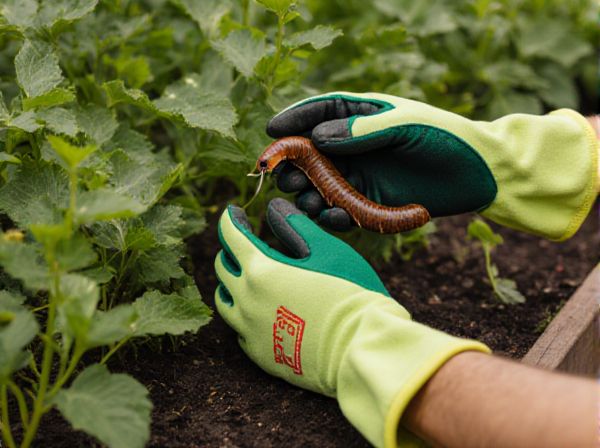
Slug bait vs Beer traps Illustration
Slug bait provides targeted control by directly attracting and poisoning slugs, making it effective for rapid population reduction. Beer traps lure slugs with fermentation scents, capturing them in a liquid solution but requiring regular maintenance to remain effective. Choosing between slug bait and beer traps depends on the severity of the infestation and the preferred environmental impact.
Table of Comparison
| Feature | Slug Bait | Beer Traps |
|---|---|---|
| Effectiveness | High, targets slugs directly with active ingredients | Moderate, attracts slugs but may trap other insects |
| Usage | Scatter around plants or soil surface | Fill shallow containers with beer near slug habitats |
| Safety | Contains chemicals, keep away from pets and children | Non-toxic, safe for pets and wildlife |
| Environmental Impact | Potential risk due to chemicals, use sparingly | Eco-friendly, biodegradable materials |
| Cost | Moderate, purchased as formulated pellets or gels | Low, uses inexpensive household beer |
| Maintenance | Apply once every few weeks or after rain | Change beer every 2-3 days to maintain attraction |
| Target Pest | Slugs specifically with toxic bait | Slugs attracted to yeast and fermentation scent |
Understanding Slug Infestations in Your Garden
Slug bait and beer traps offer effective solutions for managing slug infestations by targeting different aspects of slug behavior. Slug bait typically contains metaldehyde or iron phosphate, which is ingested by slugs and disrupts their nervous system, providing quick control in heavily infested areas. Beer traps attract slugs through fermentation odors, luring them into a container where they drown, making this method environmentally friendly but slower and best for monitoring slug populations.
What is Slug Bait? Types and Ingredients
Slug bait is a pest control product designed to attract and eliminate slugs through ingestion, commonly containing active ingredients like metaldehyde, iron phosphate, or methiocarb. Types of slug bait include pellet form, granular, and liquid options, each formulated for specific application methods and environmental safety levels. Ingredients such as iron phosphate are favored for organic gardening due to their lower toxicity to pets and wildlife, while metaldehyde-based baits offer rapid efficacy but require cautious use.
How Beer Traps Work to Catch Slugs
Beer traps attract slugs by emitting a fermented yeast scent that lures them towards the liquid. When slugs crawl into the trap, they drown due to the beer's surface tension and low viscosity. This method is effective for controlling slug populations in gardens without using harmful chemicals.
Comparing Effectiveness: Slug Bait vs Beer Traps
Slug bait delivers targeted chemical control by attracting slugs with a toxic substance that ensures high mortality rates. Beer traps rely on the fermentation scent to lure slugs, but their effectiveness varies with environmental conditions and often results in capturing fewer pests. Studies indicate slug bait generally provides more consistent and quicker slug population reduction compared to beer traps, which are better suited as supplementary control methods.
Safety Considerations for Pets and Wildlife
Slug bait, often containing metaldehyde or iron phosphate, poses significant toxicity risks to pets and wildlife if ingested, requiring careful application and secure placement. Beer traps offer a safer alternative by attracting and drowning slugs without introducing harmful chemicals, minimizing environmental impact and non-target species exposure. Choosing beer traps over chemical slug bait reduces accidental poisoning incidents and supports a pet- and wildlife-friendly pest control approach.
Environmental Impact of Slug Control Methods
Slug bait often contains chemical pesticides that can harm non-target wildlife and contaminate soil and water, raising environmental concerns. Beer traps utilize fermentation to attract and drown slugs, offering a biodegradable and less toxic alternative but require frequent maintenance to remain effective. Choosing between slug bait and beer traps depends on balancing efficacy with sustainability and minimizing ecological disruption.
Cost Efficiency: Which Method Saves You More?
Slug bait offers higher cost efficiency by requiring fewer applications and providing longer-lasting protection against slugs, reducing overall expenses. Beer traps are inexpensive initially but need frequent refilling and replacement, increasing labor and material costs over time. Choosing slug bait typically saves more money in the long run due to reduced maintenance and sustained effectiveness.
Ease of Use: Application and Maintenance
Slug bait offers straightforward application by simply spreading pellets or granules around plants, requiring minimal maintenance aside from occasional reapplication after rain. Beer traps involve filling containers with beer and setting them near affected areas, requiring regular emptying and refilling to remain effective. Overall, slug bait demands less frequent attention, making it more convenient for gardeners seeking low-maintenance pest control solutions.
Success Tips for Maximizing Slug Control
Slug bait containing iron phosphate offers effective slug control by directly targeting slugs with minimal harm to pets and wildlife. Beer traps attract slugs through fermentation scents but may require frequent monitoring and refilling to maintain effectiveness. Combining slug bait application around garden beds with strategically placed beer traps enhances slug control success by addressing different slug behaviors and feeding patterns.
Choosing the Best Method for Your Garden
Slug bait offers targeted control by using chemical or organic pellets that actively attract and kill slugs, making it effective for maintaining garden health and protecting plants. Beer traps lure slugs with fermenting yeast, capturing them in a liquid solution, which is a non-toxic and eco-friendly option but may require frequent maintenance. Selecting the best method depends on the garden size, desired level of control, and environmental considerations, with slug bait preferred for heavy infestations and beer traps suited for smaller, organic-focused gardens.
Slug bait vs Beer traps Infographic

 gardendif.com
gardendif.com